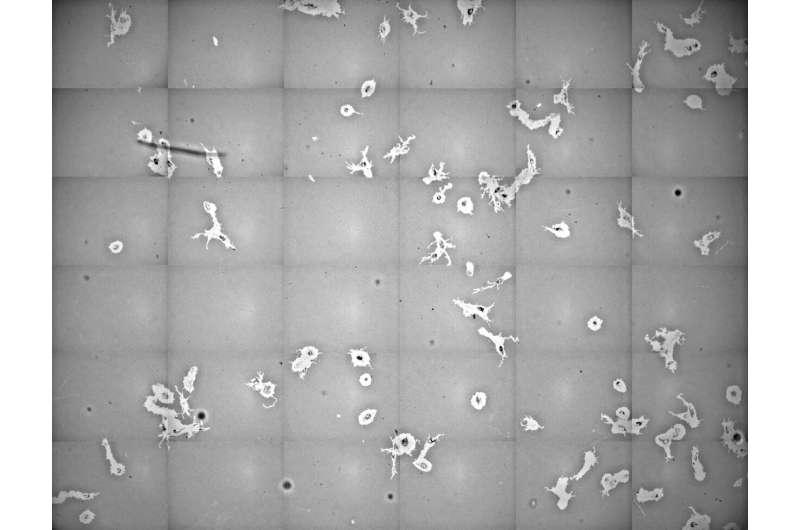Microscope image of moving breast cancer cells leaving a track. Koedoot: "We switched of certain proteins and then looked to see if the pathways changed." Credit: Esmee Koedoot
Ph.D. student Esmee Koedoot studied the underlying processes responsible for metastases in a dangerous type of breast cancer. She hopes to find new possibilities to fight the disease. In December 2019 she obtained her doctorate cum laude.
One out of every eight women gets breast cancer in her life. It is therefore the most common cancer among women worldwide, and also the most deadly. The latter is mainly due to the fact that breast cancer often spreads to vital organs, such as the liver and lungs. Koedoot studied the deadliest subtype of breast cancer: triple-negative breast cancer, or TNBC. The classification into subtypes is based on so-called hormone receptors. These are proteins on the surface of a cell, which transmit signals from hormones outside the cell to other proteins within the cell. In many types of breast cancer, the tumour cells have extra-large amounts of these hormone receptors. These receptors can serve as targets for medication.
Hormone therapy is widely used and successful. "The problem with TNBC, however, is that the tumour cells have very low levels of hormone receptors," says Koedoot. "As a result, existing hormone therapies have no effect." The current treatment for TNBC therefore still consists of the surgical removal of the tumour, in combination with chemotherapy and/or radiation. In order to change this, Koedoot focused on the genes that play a role in the metastasis of TNBC.
Despite the fact that TNBC only accounts for about one-fifth of all breast cancer cases, this subtype is responsible for the majority of breast cancer related metastases and mortality. Whereas in the other subtypes 7 percent of women die within five years of diagnosis, for TNBC this is 23 percent.
Cut and paste
Koedoot discovered that the RNA splicing process plays a crucial role in the growth, movement and metastasis of TNBC cells. She explains how it works: "In a tumour cell, DNA contains the code for RNA. RNA is, as it were, the recipe for producing proteins, the cell's workers. Before the cell can read the RNA to produce a protein, all unnecessary pieces of RNA have to be cut and the remaining pieces glued together. This process is called RNA splicing. No less than 244 different proteins are involved. These are the so-called splicing factors."
"We have created a database of genes involved in the metastasis of TNBC and looked at the role of the splicing factors. We discovered several splicing factors that are essential for the movement of the aggressive cancer cells: If we switch off such a protein, we see that the cell moves less rapidly. In this way, we can limit metastases."
New therapies
Koedoot studied no less than 4000 genes and selected the best for follow-up research. "Due to limited time, we were only able to investigate a few of these genes ourselves, but we put all the results online. That way, other researchers can take advantage of them and use the results for follow-up research."
It is the first time that someone has so clearly identified the role of RNA splicing factors in breast cancer. "And that is very important for our understanding of processes involved in the spread of TNBC. We've even discovered some splicing factors that we could use as targets for new drugs. I hope that in this way my research will help to combat metastases and reduce mortality from breast cancer."
Provided by Leiden University























